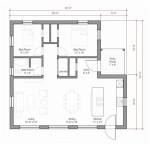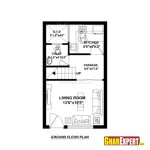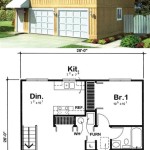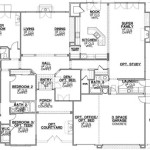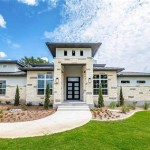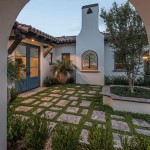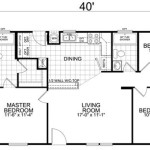House Plans with Simple Roof Lines: A Streamlined Approach to Home Design
The selection of a roof design is a pivotal decision in the process of creating a house plan. Beyond its functional role in protecting the structure from the elements, the roof significantly influences the aesthetic appeal and overall cost of the building. House plans incorporating simple roof lines have gained considerable popularity due to their cost-effectiveness, ease of construction, and timeless architectural style. This article explores the advantages of simple roof designs, examines common types, and provides considerations for integrating them into a comprehensive house plan.
A house plan with a simple roof line prioritizes efficiency and practicality without sacrificing visual appeal. This approach often leads to faster construction timelines and reduced labor costs, making it an attractive option for budget-conscious homeowners and builders. The elegance of simplicity allows for a focus on other design elements, such as landscaping, interior finishes, and architectural details on the facade.
Cost-Effectiveness and Enhanced Energy Efficiency
One of the most compelling arguments for choosing a house plan with a simple roof line is its economical advantages. The reduced complexity in design translates directly to lower material costs. Simple roofs require fewer specialized components, less intricate framing, and less labor. This reduction in complexity streamlines the construction process, minimizing potential errors and delays. Furthermore, the simplified design often leads to less waste, which is both environmentally and financially beneficial.
Beyond the initial construction cost savings, simple roof lines can contribute to long-term energy efficiency. A streamlined roof profile reduces the surface area exposed to the elements, minimizing heat gain in the summer and heat loss in the winter. This characteristic is particularly advantageous in regions with extreme climates. Moreover, simple roofs are often easier to insulate effectively. With fewer complex angles and junctions, insulation can be applied more consistently and thoroughly, reducing thermal bridging and improving the overall energy performance of the home. This enhanced insulation can lead to significant savings on heating and cooling bills over the lifespan of the house.
From a maintenance perspective, simple roof lines are often easier and less expensive to maintain. They typically have fewer areas where water can accumulate, reducing the risk of leaks and water damage. Repairs and inspections are also simpler to perform due to the straightforward design. This ease of maintenance contributes to lower long-term ownership costs.
Common Types of Simple Roof Designs
Several common roof designs qualify as simple designs, each with its distinct characteristics and aesthetic appeal. The gable roof, hip roof, and shed roof are among the most frequently chosen options for house plans aiming for simplicity.
Gable Roof: The gable roof is characterized by two sloping sides that meet at a ridge, forming a triangular shape. This is one of the most basic and recognizable roof forms. Gable roofs are relatively easy to construct and offer good water runoff. The simple design allows for ample attic space and ventilation. The straightforward geometry facilitates the installation of solar panels. The simplicity of the gable roof makes it compatible with a wide range of architectural styles, from traditional to contemporary.
Hip Roof: A hip roof features slopes on all four sides, with each side sloping down to the walls. This design provides greater stability compared to gable roofs, particularly in areas prone to high winds. Hip roofs offer a more streamlined appearance and can be visually appealing. While slightly more complex to construct than gable roofs, the hip roof remains a relatively simple design compared to more elaborate roof structures. The sloped sides provide good water runoff and can be adapted to various house plan configurations.
Shed Roof: A shed roof, also known as a skillion roof, features a single sloping surface. This design is often used for additions, modern homes, and houses with a minimalist aesthetic. Shed roofs offer simplicity and cost-effectiveness. They can be oriented to maximize solar gain or provide optimal drainage. The simplicity of the shed roof facilitates easy construction and requires minimal materials. This design is particularly well-suited for contemporary architectural styles and homes seeking a clean, uncluttered look.
While flat roofs may appear to be the simplest form, they require specialized construction techniques and roofing materials to ensure proper drainage and prevent water damage. Therefore, a flat roof, while visually simple, may not always be the most straightforward or cost-effective option in terms of construction and maintenance.
Integrating Simple Roof Lines into House Plans
Successfully integrating a simple roof line into a house plan requires careful consideration of the architectural style, structural requirements, and aesthetic goals. The choice of roofing materials, overhangs, and detailing can significantly impact the overall appearance and performance of the roof.
The selection of roofing materials is crucial in complementing the simple roof design. Asphalt shingles are a popular and cost-effective option, offering a wide range of colors and styles. Metal roofing provides durability and longevity, while also contributing to a modern aesthetic. Tile roofing can add a touch of elegance, although it may be more expensive and require additional structural support. The choice of roofing material should be based on factors such as budget, climate, and desired aesthetic.
Overhangs play a vital role in protecting the house from the elements. They help to deflect rainwater away from the walls, preventing water damage and reducing the risk of mold growth. Overhangs also provide shade, reducing heat gain in the summer and lowering cooling costs. A well-designed overhang can enhance the architectural appearance of the house, adding depth and visual interest.
Detailing, such as the design of the eaves, fascia, and soffit, can further enhance the aesthetic appeal of a simple roof. Clean lines and simple shapes are often preferred to maintain the overall minimalist aesthetic. Thoughtful detailing can elevate the design and create a cohesive and visually appealing home.
When designing a house plan with a simple roof line, it is essential to consider the orientation of the house on the lot. Proper orientation can maximize solar gain in the winter and minimize it in the summer, optimizing energy efficiency. The roof design can also be adapted to accommodate solar panels, further enhancing the home's sustainability.
The interior layout of the house should also be considered in conjunction with the roof design. Simple roof lines can create opportunities for open floor plans and vaulted ceilings, enhancing the sense of space and light. The roof structure can be integrated into the interior design, creating unique architectural features.
In conclusion, house plans with simple roof lines offer a range of benefits, including cost-effectiveness, energy efficiency, and ease of construction. By carefully considering the design elements, materials, and integration with the overall house plan, homeowners can create a beautiful and functional home that meets their needs and budget.
The inherent simplicity of certain roof designs allows for resources to be allocated elsewhere within the build, such as higher quality windows, upgraded insulation, or more refined interior finishes. This strategic distribution of resources can result in a home that offers both long-term value and enhanced comfort.
Furthermore, the adaptability of simple rooflines should be noted. While inherently straightforward, they can be combined with more complex architectural elements to create unique and visually interesting homes. For example, a simple gable roof might be combined with dormers to add visual interest and increase attic space. Similarly, a shed roof could be incorporated into a modern design with large windows and clean lines.
Ultimately, the decision to opt for a simple roofline is one that should be made in consultation with a qualified architect or building designer. These professionals can provide valuable guidance in selecting the most appropriate roof design for a particular site, climate, and architectural style. They can also ensure that the roof is properly engineered and constructed to meet all relevant building codes and standards.

Simple Rooflines 92024vs Architectural Designs House Plans

Exterior House Designs

Simple House Plans With Porches Wrap Around Porch

Modern Style Family Home With Graceful Gable Roofs Cool House Concepts

Stylish And Simple Inexpensive House Plans To Build Houseplans Blog Com

Simple Two Bedroom House Pinoy Plans

Small House Plan Ch18

Stylish Contemporary Home Design With Shed Roof Pinoy House Plans

Modern And Cool Shed Roof House Plans Houseplans Blog Com

Modern House Roof Designs With S Makanwalay

